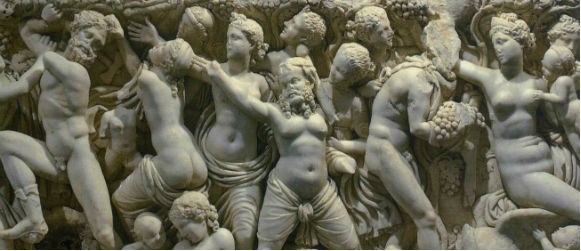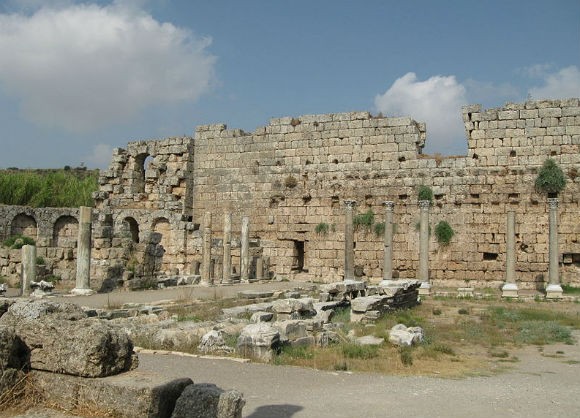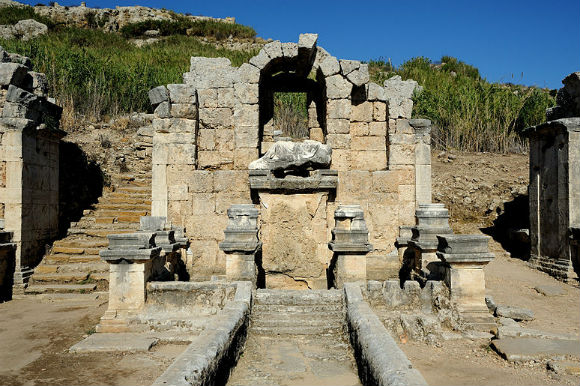Perga was an old city even in the first century. Its name (which is not Greek) indicates that its origin dates from pre-Greek times. Alexander the Great passed through it twice while the Pergaeans offered no resistance to him although it was a walled city with a citadel. In Roman times the main streets were over twenty-one meters wide. They were lined with Ionic colonnades and a water channel ran down their center in a series of small waterfalls as in Antalya today. Behind the colonnades stood the shops. Of the early buildings the stadium and the theater have survived the ravages of earthquakes and wars with the least damage. In fact this stadium which could seat about fourteen thousand people is one of the best preserved in Turkey.
The temple of the Pergaean Artemis according to a writer of the time was “a marvel of size, beauty, and workmanship.” Its location has yet to be established; it may have been where there are now ruins of a Byzantine church on a hill to the southeast of the city.
Perga is on a rise not far from the Cestrus River which was navigable In Paul’s time. It was not a seaport in terms of Its being directly on the Mediterranean even then, but rather it was more easily defended where it was: its distance from the open sea made it less vulnerable to piracy.
Two people stand out among the early residents of Perga. Apollonius was a third century B.C. astronomer and mathematician who believed that the movements of heavenly bodies in the universe were explainable by orbits within orbits: that the moon went around the earth as the earth went around the sun. He was much ahead of his time in his theories of astronomy, so much so that the ideas had to be rediscovered during the Renaissance. Plancia Magna was unusual for a second century A.D. woman: she held the highest city office during her life, that of demiurgus. She must have been well-to-do for a number of inscriptions record her gifts to the city.
Paul and Barnabas went through Perga on their way to and from Antioch on their first journey (Acts 13:13, 14:25). John Mark was with them at first but left them at Perga to return to Jerusalem. The reason for that must have been such that Paul doubted his commitment to the cause. Later when Paul and Barnabas were about to start on their second journey from Antioch they had a sharp dispute over his worthiness. Paul refused to have him go along, so John and Barnabas went to Cyprus while Paul chose Silas to accompany him.
Paul talks in II Corinthians 12:7 and in Galatians 4:13-14 of bodily illness that brought him to Galatia the first time. It may have been on that account that he did not stay long in Perga the first time. Whatever the illness was, it seems to have improved in time in the dry mountain air to the north.
The second theory of why they did not stay long in Perga is that their interview with Sergius Paulus, the proconsul of Cyprus, had made them want to hurry to the Roman colony in Antioch of Pisidia. This interpretation may lay too much stress on the lasting importance of that meeting with a cultured Roman who could have been more interested in the pursuits of the mind than the salvation, in Christian terms, of his soul. It is interesting, however, that this is” the point in Acts (13:9) that Luke begins to call Paul by his Roman name, not his Jewish “Saul”.
On their return they did stay in Perga long enough to preach and talk with people there. Nothing else is told about the city or their time there.
Perga,






A must see if you are visiting the Antalya area. Try to book a tour to the sites you will be able to see them much easier than doing it on your own. Very well preserved Roman/Greek ruins. Great photo opportunities. A do not miss on your holiday.
Both very interesting and worth the visit. Easy to get to on public transport and a lot cheaper than a tour.
The ruins are so vast and you can walk into each site and touch and feel how it was in 1275 BC. Many of the ruins are still intact and they are restoring the site every day. This is a massive site and well worth the visit.
Try to gt there around 8:30 AM before the tour busses arrive and you will have the entire place to yourself, the better to imagine what life was like so long ago.
You need to see the artifacts at the Archeological Museumm to really appreciate what an important site this is.
Part of a Thomas Cook tour, a good introduction to Roman archeaology
Very interesting even my husband thought so and he usually hates walking around ruins. There was a lot to see and we spent around 2 hours there. There is so much intact it is not just a pile of stones, you can make out the shops and houses etc.
On a business trip to the area I took a day to check out the ruins. Hard to fathom the architectural genius that created the amphitheatre. While standing at the top one of our group standing at the base broke out singing a cappella. Each word and tone were crystal clear, never mind that the singer had a good voice….
Very nicely preserved ancient city. It's pretty amazing in that you can still see old shops, and the amphitheatre, and all that jazz.
I also personally like it because it's semi-accessible by public transit, so a cheap trip if you're staying at Kundu Beach. We managed to take a public bus there and walk or hitch-hike a short distance. The…
It is early afternoon and I`m gazing at some ruins in the historical city of Perge. Marble stones, stone columns, archeological finds of different sizes and importance are scattered around. Here before me some 2500 years ago, maybe even as early as 4000 years back as the signpost at the entrance indicates people have lived, worked, procreated, and died. I`m…